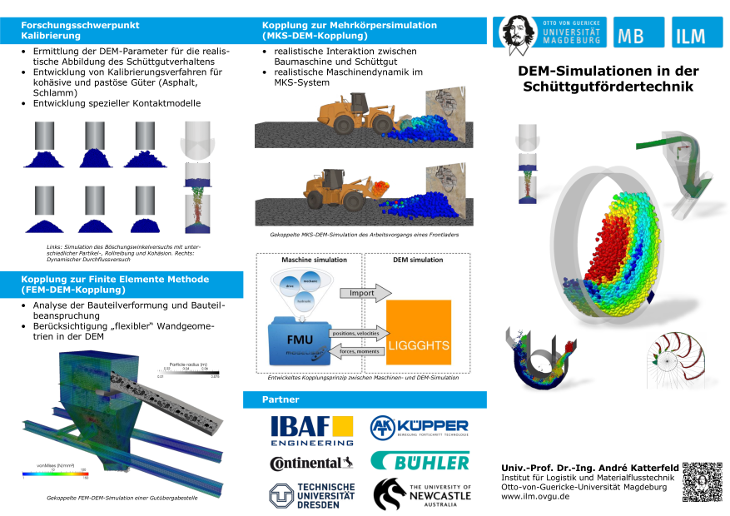Discrete Element Method
These pages will no longer be maintained from 16.1.25.
You can find the web presence of the Chair of Material Handling at www.fmt.ovgu.de/en
Use of the discrete element method (DEM) for simulation of bulk material
The Term
The Discrete Element Method (DEM) was developed by Cundall and Strack [1] in the ´ 70s in order to solve problems from rock mechanics. Cundall and Hart [2] proposed to use the term discrete element method for algorithms that allowed finite displacements and rotations of discrete bodies including their complete separation. Moreover, these algorithms needed to be able to detect new contacts automatically.
The requirements defined above for DEM were also met by event driven methods. In order to distinguish the soft contacts model of finite duration from the event driven methods, Cundall and Strack [1] used term distinct element method. However, in literature this differentiation is not always followed and often the term distinct element method is replaced by the term discrete element method. In natural sciences the term time driven Molecular Dynamics (MD) is used where, in the ´ 60s, a variant of the Molecular Dynamics was applied by Rahman [3] to Lennard-Jones-Particles and it is equivalent to DEM.
The potential of DEM was recognized quickly and for research purposes in a number of areas, such as Physics, Nanotechnology, Chemical Engineering and Materials Handling, from which many DEM-algorithms have been devolved.
The Method
For the Discrete Element Method the discrete elements, e.g. the particles of bulk solids, need to be approximated by geometrically describable objects. Since, generally, the transition from a continuum mechanical model to a particle mechanical model leads to much more realistic results, the usage of simple spheres is sufficient for many cases. More complex shapes can be modelled by merging overlapped spheres to form rigid bodies.
The contact points of the particles are described by adequate contact models, such as elastic force displacement laws, Coulomb friction and viscous damping (Fig. 1). Moreover attractive forces such as Van-der-Waals forces and liquid bridge forces can be considered which allows modelling of cohesive particulate systems.

From all the forces acting on a particle, a resulting force is computed. Using this force the Newtonian equation of motion can be solved for a very short time step, which subsequently delivers the new position and velocity for this particle. This is done for each particle of within system. Therefore, after each time step, new contact detection needs to be performed as new contacts might have been formed or existing one might have vanished. By applying this cycle repeatedly the evolution of the particulate system with time is simulated. Machine parts, walls or other boundary conditions can be considered by geometric objects, such as prisms, cylinders, cones and screws.
Our Flyer for Download
Literature
[1] Cundall, P.A.; Strack, O. D. L.: A discrete numerical model for granular assemblies. Geotechnique, 29 (1979) 1, 47-65
[2] Cundall, P. A, Hart, R. D.: Numerical Modelling of Diskontinua. 1st US Conference on DEM, Eng. Comput., 9 (1992) 2, S. 101-113
[3] Rahman, A.: Correlations in the motion of atoms in liquid argon. Phys. Rev., 136 (1964) 2A, S. 405-411
